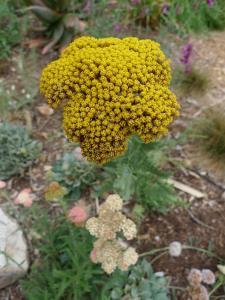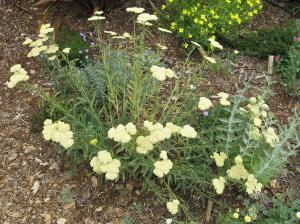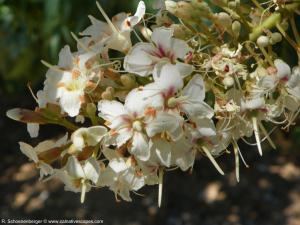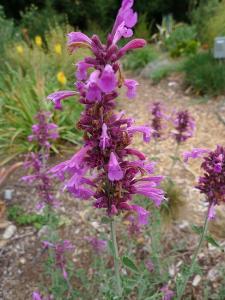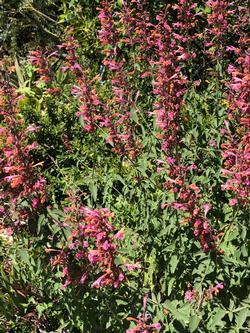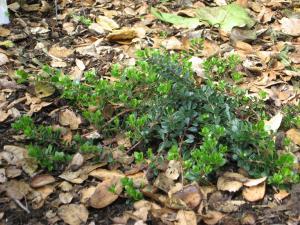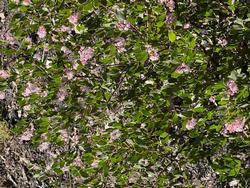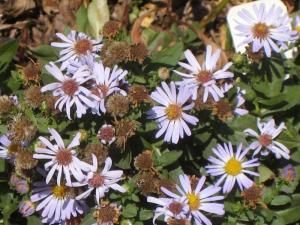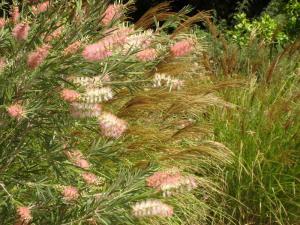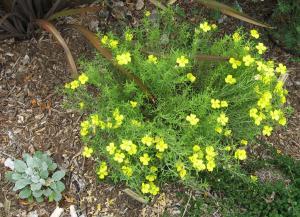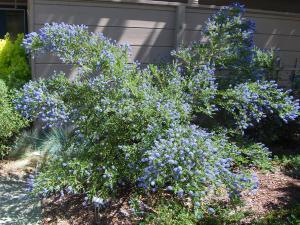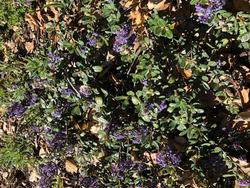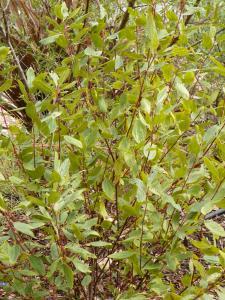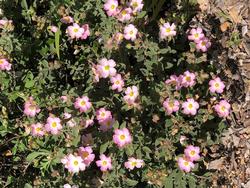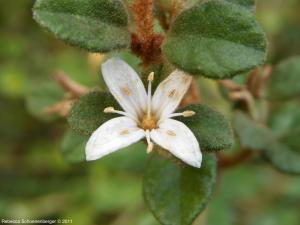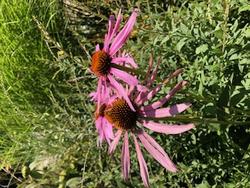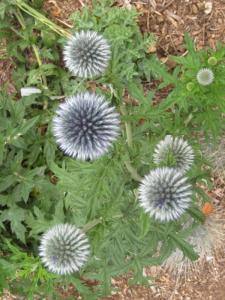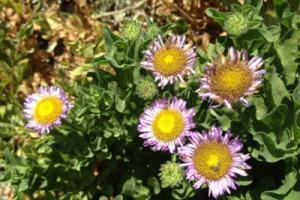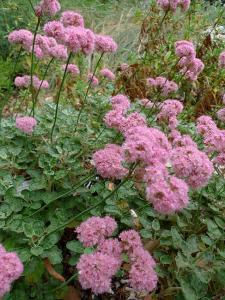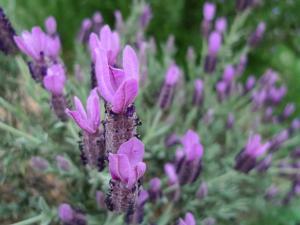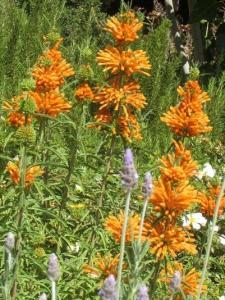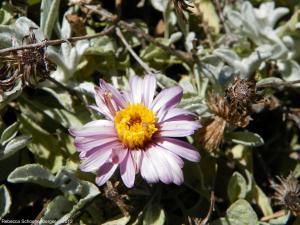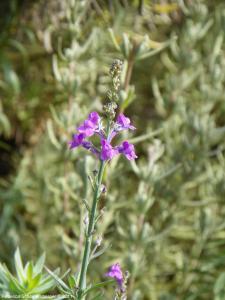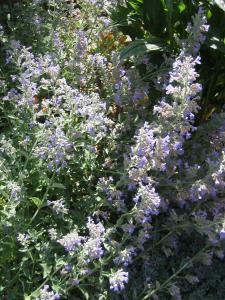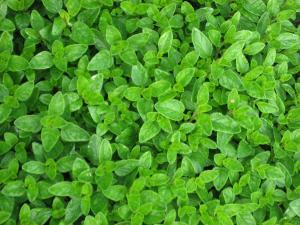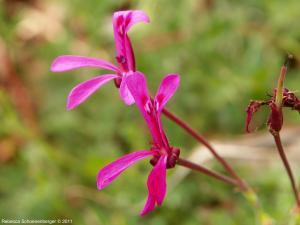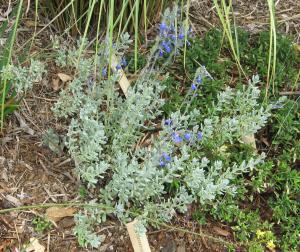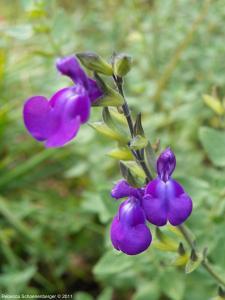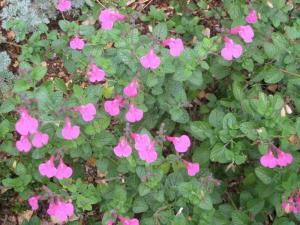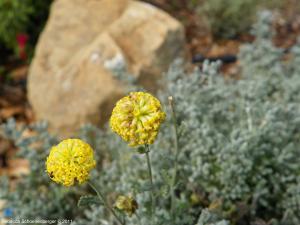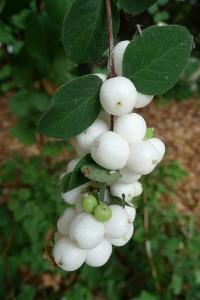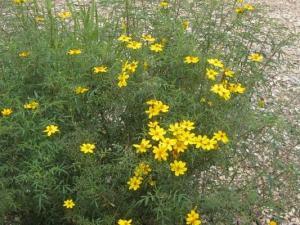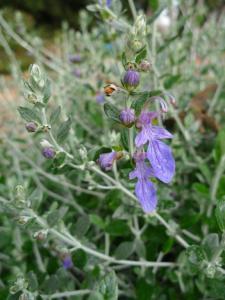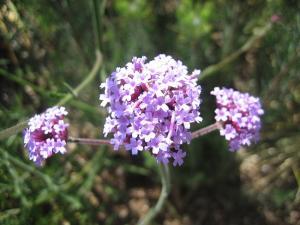Water Wise Plants
Here's a full list of all our water wise plants. You can also view an image gallery, or view the plants by categories.
Achillea ‘Moonshine’
Pronunciation
ah-KILL-lee-ah
Common Name
Yarrow ‘Moonshine’
Plant Type
Perennial
Mature Size
2 ft.
Water Requirements
Low: water every three weeks until the root ball is wet
Sun/Shade Requirements
Full sun
Wildlife
Flower Color
Bright yellow
Where to See
Maintenance- Design- Planting Tips
Achillea ‘Moonshine’ is a reliable mid-summer bloomer whose deep yellow flowers will stand out in a garden. Requiring very little maintenance, these plants are a magnet for butterflies and beneficial insects. The flowers have lots of nectar and the flat shape of the flower serves as a perfect landing pad for butterflies. Deadhead spent flowers to keep the plants looking fresh. Vigorous clumps can be divided in the winter. |
Achillea ‘Taygetea’
Pronunciation
ah-KILL-lee-ah tay-GET-ee-uh
Common Name
Yarrow ‘Taygetea’
Plant Type
Perennial
Mature Size
12 in. to 18 in. wide and tall
Water Requirements
Low: water every three weeks until the root ball is wet
Sun/Shade Requirements
Full sun
Wildlife
Flower Color
Creamy yellow
Where to See
Maintenance- Design- Planting Tips
‘Taygetea’ Greek yarrow is a cheerful, reliable summer bloomer. The flowers start out bright yellow in midsummer and fade to a more mellow shade over time. The grey-green foliage blends in well with many plants found in low water gardens. This cultivar of yarrow seems to be more drought tolerant than the popular Achillea millifolium.
Greek yarrow doesn't need a great deal of maintenance. To encourage reblooming, deadhead it regularly. This plant will spread, so don't plant it too tightly. |
Aesculus californica
Pronunciation
ES-kew-lus ka-li-FOR-ni-ka
Common Name
California Buckeye
Plant Type
Tree
Mature Size
Can grow 10 - 25 ft. or more, and spread 30 ft. or wider
Water Requirements
Very Low: water deeply several times a summer
Sun/Shade Requirements
Full to half sun, shade
Wildlife
Flower Color
White to pink
Where to See
Maintenance- Design- Planting Tips
The California buckeye is an unusual native because it is summer deciduous. It will naturally drop its leaves with the heat of summer, but with regular watering it may hold leaves longer. Its nectar/pollen is poisonous to European honeybees, but not to native bees. The flower has a candy or perfume-like scent, and blooms in very early spring.
The tree produces a large nut that resembles a buck's eye, thus the name. The nut is poisonous to eat. The nuts easily reseed where they fall, so collect them if new sprouts are not desired. Without summer leaves, the pale bark of the California buckeye offers interest and structure in the garden and is very easy to prune and shape. |
Agastache
Pronunciation
ag-ah-STAK-ee
Common Name
Agastache
Plant Type
Perennial
Mature Size
3 ft. wide and 2 ft. tall
Water Requirements
Low: water every three weeks until the root ball is wet
Sun/Shade Requirements
Full sun
Wildlife
Flower Color
Pink
Where to See
Maintenance- Design- Planting Tips
Agastache are originally from the Southwest and Mexico, a climate that is somewhat different from Santa Clara County’s Mediterranean summer-dry climate. These plants require well-draining soil, but local soils tend to be slow-draining clay soils.
PADG notes: This unnamed cultivar of Agastache has been a mixed success in our gardens. |
Agastache ‘Acapulco Salmon and Pink’
Pronunciation
ah-ga-STAHK-ee
Common Name
Hummingbird mint
Plant Type
Perennial
Mature Size
2'-2.5' high x 1.5' wide
Water Requirements
Moderate: water weekly until the root ball is wet
Sun/Shade Requirements
Full to half sun
Wildlife
Flower Color
Orange and Pink
Where to See
Maintenance- Design- Planting Tips
Agastache ‘Acapulco Salmon and Pink’ is a beautiful accent plant for the late spring to early fall garden. It is more compact than most hummingbird mints and is densely covered by orange and pink flower spikes. The plant’s gray-green foliage is also a nice contrast to the brighter greens of most garden plants. Like many perennials, these plants die back during the winter. Hummingbird mints are only moderately drought tolerant. This plant does not flower well unless it is in full sun for half a day or more.
PADG notes: This specimen is planted where it gets morning sun and afternoon shade so it needs less water than recommended. During hot, summer periods, the plant is hosed weekly in addition to a once every three-week drip irrigation cycle. |
Arctostaphylos ‘Emerald Carpet’
Pronunciation
ark-toe-STAF-il-lohs
Common Name
Manzanita ‘Emerald Carpet’
Plant Type
Groundcover
Mature Size
5 ft. wide and 8-14 in. tall
Water Requirements
Low: water every three weeks until the root ball is wet
Sun/Shade Requirements
Full to half sun
Wildlife
Flower Color
Pink flowers
Where to See
Maintenance- Design- Planting Tips
‘Emerald Carpet’ is a slow growing California native manzanita from the coast of Mendocino County. It is a very attractive plant with dark glossy leaves, reddish stems and small flowers in the early spring. There are many different cultivars of manzanita, ranging from ground covers to small trees. Manzanitas are a good wildlife plant and typically are a hearty plant. They do well in very dry situations. Most manzanitas need superb drainage, or they will struggle and die. Plant on a mound or slope and water weekly for the first summer and less after that. By the third summer, stop watering. Avoid fertilizing the plant. These plants rarely need pruning. Remove the odd branch that dies back in the late summer and the plant will fill in. Some gardeners will remove the lower branches on some of the larger manzanitas to highlight the interesting branching structure and reddish bark. Some Santa Clara Master Gardeners have had success using the cultivar ‘Carmel Sur’ as a ground cover in low-water landscapes. PADG notes: ‘Emerald Carpet’ has not thrived at PADG. It may need more water than most manzanitas. |
Arctostaphylos densiflora ‘Howard McMinn’
Pronunciation
ark-toe-STAF-i-los den-si-FLOR-us
Common Name
Manzanita ‘Howard McMinn’
Plant Type
Shrub
Mature Size
5-7 ft tall x 6-10 ft wide
Water Requirements
Very Low: water deeply several times a summer
Sun/Shade Requirements
Full to half sun
Wildlife
Flower Color
Whitish pink
Maintenance- Design- Planting Tips
California native Arctostaphylos ‘Howard McMinn’ is reputed to be the manzanita most tolerant of typical garden conditions. Manzanitas in general need excellent drainage. In heavy clay soils, be careful not to over water or over fertilize.
If the tips of Arctostaphylos branches are pruned, this large shrub will become very dense and make a good privacy screen. Removing the interior stems and leaves instead exposes the interesting red bark. The latter is a good approach for making the shrub more of a focal point instead of a background plant. PADG notes: PADG planted three ‘Howard McMinn’ manzanitas at the entrance of the Water Wise Garden. They have struggled there over the years, damaged by foot traffic and the occasional joy rider. |
Artemisia douglasiana
Pronunciation
art-ee-MIS-ee-uh dug-las-ee-AH-nuh
Common Name
Douglas' Sagewort
Plant Type
Perennial
Mature Size
4 ft (1.2 m) wide x 8 ft (2.4 m) tall
Water Requirements
Moderate: water weekly until the root ball is wet
Sun/Shade Requirements
Half sun to shade
Wildlife
Flower Color
Cream, White, Yellow
Where to See
Maintenance- Design- Planting Tips
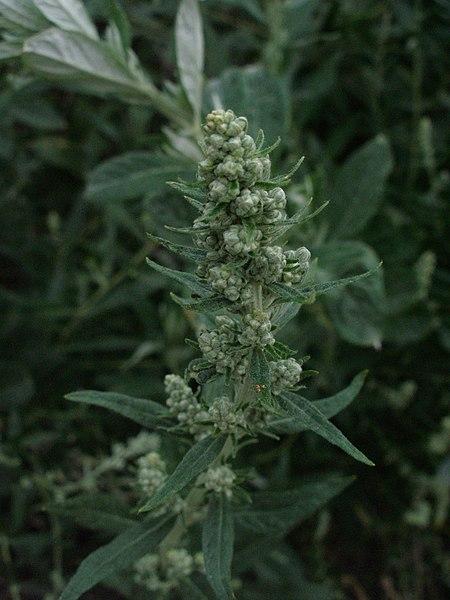
|
Aster chilensis
Pronunciation
ASS-ter chil-EN-sis
Common Name
California Aster
Plant Type
Perennial
Mature Size
2 ft. to 3 ft. wide and 18 in. to 3 ft. tall
Water Requirements
Very Low: water deeply several times a summer
Sun/Shade Requirements
Full to half sun
Wildlife
Flower Color
Purple, pale blue or white
Where to See
Maintenance- Design- Planting Tips
This California native is a low growing, late summer bloomer that shines when much of the garden is quiet. It works well in the front of a low water perennial bed or native plant border.
California aster looks best if regularly deadheaded. After it is done blooming in the fall, shear it back to the ground to keep a tidy look in the garden. The plant will cheerfully return when winter is over. PADG notes: California aster spread very rapidly even without supplemental water. It might work better in a situation where a rapidly spreading plant is needed for erosion control rather than in a small, mixed perennial bed. |
Callistemon ‘Canes Hybrid’
Pronunciation
kal-is-TEM-on
Common Name
Bottlebrush
Plant Type
Shrub
Mature Size
8 ft. to 10 ft. wide and tall
Water Requirements
Low: water every three weeks until the root ball is wet
Sun/Shade Requirements
Full to half sun
Wildlife
Flower Color
Soft pink
Where to See
Maintenance- Design- Planting Tips
Callistemon ‘Canes Hybrid’ is a beautiful shrub that adds height and structure to the perennial garden, with soft pink flowers that bloom repeatedly throughout the summer. The cultivar ‘Canes Hybrid’ is smaller and has softer, greyer foliage than the more common red Callistemon citrinus.
Callistemon are very adaptable plants for Santa Clara Valley gardens and are attractive to hummingbirds. The many cultivars of Callistemon range from tree-size to shrub-size to ground cover height. PADG notes: The Callistemon is pruned and shaped to a shrub and is has been planted next to Miscanthus sinensis ‘Yaku Jima’ as seen in the photo. |
Calylophus hartwegii
Pronunciation
kal-ee-LOW-fus heart-WEHG-ee-eye
Common Name
Sundrops
Plant Type
Perennial
Mature Size
1.5 ft. high and 2 ft. wide
Water Requirements
Low: water every three weeks until the root ball is wet
Sun/Shade Requirements
Full to half sun
Wildlife
Flower Color
Where to See
Maintenance- Design- Planting Tips
Calylophus hartwegii is a showy, low growing perennial. The flowers, which appear in mid-summer, are bright yellow. The delicate, lacy foliage is also an attractive addition to the garden. It is native to the southwestern US and northern Mexico.
Sunset’s Western Garden Book suggests shearing before spring growth. The stems on these plants can become woody. |
Ceanothus ‘Concha’
Pronunciation
see-a-NO-thus
Common Name
California Wild Lilac ‘Concha’
Plant Type
Shrub
Mature Size
6-8 ft tall x 6-8 ft wide
Water Requirements
Very Low: water deeply several times a summer
Sun/Shade Requirements
Full to half sun
Wildlife
Flower Color
Blue
Where to See
Maintenance- Design- Planting Tips
Ceanothus ‘Concha’ is a California native plant with rose colored buds that open to cobalt blue flowers in late winter or early spring. Leaves are small and a deep dark green.
‘Concha’ is one of the best Ceanothus cultivars for Santa Clara County. It is more adaptable to typical garden environments than many other Ceanothus, tolerating heavy clay soil, drought, or summer watering. Overwatering will shorten the life of any Ceanothus so be sure to allow the soil to dry between waterings. |
Ceanothus maritimus ‘Valley Violet’
Pronunciation
see-an-OH-thus muh-RIT-tim-mus
Common Name
Maritime ceanothus
Plant Type
Shrub
Mature Size
1'-3' high x 3'-8' wide
Water Requirements
Low: water every three weeks until the root ball is wet
Sun/Shade Requirements
Full sun
Wildlife
Flower Color
Maintenance- Design- Planting Tips
Ceanothus maritimus ‘Valley Violet’ is a California native and a UC Davis Arboretum All-Star. This low growing Ceanothus has a wide spread and can be an effective ground cover. It has dark, blue-green foliage that contrasts nicely with its purple flowers, which bloom from winter into spring. Be aware that all Ceanothus develop buckthorns as they age that can be very sharp.
PADG notes: Several varieties of Ceanothus were planted several years ago in the Native Bed at the Palo Alto Demonstration Garden. As of 2022, Ceanothus maritimus ‘Valley Violet’ is doing the best in the group. It is very drought tolerant and is living up to its All-Star status with the garden’s dry season irrigation cycle. Established plants are watered once every three weeks with drip lines. |
Ceanothus x pallidus ‘Marie Simon’
Pronunciation
see-an-OH-thus PAL-id-us
Common Name
Wild Lilac ‘Marie Simon’
Plant Type
Shrub
Mature Size
Up to 6 - 8 ft. high and wide
Water Requirements
Low: water every three weeks until the root ball is wet
Sun/Shade Requirements
Full to half sun
Wildlife
Flower Color
Where to See
Maintenance- Design- Planting Tips
Ceanothus x pallidus ‘Marie Simon’ is a cross between a native Ceanothus and another unknown plant, and is a UC Davis Arboretum All-Star. It looks quite different from a native Ceanothus. It is semi-deciduous, with red stems and light green leaves, and its flowers are a delicate pink instead of the blue more typical for Ceanothus.
PADG notes: Online photos show a plant covered with pink flowers but that hasn’t been the case at the Demonstration Garden. The flowers have been pretty but sparse and the plant does not look vigorous. It has been in the garden for several years and is still a non-performer. We can’t recommend this plant for low water gardens in the Palo Alto area. |
Cistus x argenteus ‘Silver Pink’
Pronunciation
SIS-tus x (ar-JEN-tee-us)
Common Name
Rock Rose
Plant Type
Shrub
Mature Size
2'-3' high x 4'-5' wide
Water Requirements
Low: water every three weeks until the root ball is wet
Sun/Shade Requirements
Full sun
Wildlife
Flower Color
Pink and White
Where to See
Maintenance- Design- Planting Tips
Cistus x argenteus ‘Silver Pink’ has small flowers that densely cover the plant in the spring. At the end of the season the flowers drop off cleanly. This beautiful evergreen shrub naturally grows into a neat, compact mound, with dense, gray-green foliage. It should never be pruned heavily. Like many drought tolerant plants, a heavy pruning can kill it or leave it misshapen. Instead, be sure to allow enough space for the mature shrub in your landscape design so that pruning is not necessary.
|
Correa alba
Pronunciation
KOR-ree-uh AL-ba
Common Name
Australian Fuchsia, White
Plant Type
Shrub
Mature Size
8 ft. high and wide
Water Requirements
Low: water every three weeks until the root ball is wet
Sun/Shade Requirements
Full to half sun, shade
Wildlife
Flower Color
Where to See
Maintenance- Design- Planting Tips
Correa alba looks very different from the more commonly grown Correa ‘Dusky Bells’. The flowers are more open and less downward facing than other Correas. The foliage is fuzzy on the back side and the stems are bronzy brown. This shrub can grow to 8 feet by 8 feet without regular pruning.
Like Correa ‘Dusky Bells’, Correa alba thrives in sun, partial sun, or shade; is deer resistant and bird friendly; and has long-lasting flowers. The plant does well with moderate to occasional water, tolerates alkaline soil, and is evergreen. The plant is sensitive to overwatering and overfertilizing. PADG notes: Some find Correas to be short-lived but at the Palo Alto Demonstration Garden, this plant is still going strong after several years in the garden. The beds in garden are mulched with wood chips, but not fertilized and watered deeply with drip irrigation once every three weeks. |
Echinacea purpurea
Pronunciation
ek-ih-AY-shee-a pur-PUR-ee-ah
Common Name
Purple cone flower
Plant Type
Perennial
Mature Size
3'-4' high x 2' wide
Water Requirements
Low: water every three weeks until the root ball is wet
Sun/Shade Requirements
Full sun
Wildlife
Flower Color
Purple
Where to See
Maintenance- Design- Planting Tips
Echinacea purpurea is a green-leaved perennial that produces large purple, daisy-like blooms in the summer. It can grow to four feet in height and works well in the background of garden borders. It needs minimal drip irrigation, dies down after bloom, and resprouts in the spring with little extra maintenance required. |
Echinops ritro ‘Taplow Blue’
Pronunciation
EK-in-ops RIH-tro
Common Name
Globe Thistle
Plant Type
Perennial
Mature Size
2 - 4 ft. tall and 2 ft. wide
Water Requirements
Low: water every three weeks until the root ball is wet
Sun/Shade Requirements
Full sun
Wildlife
Flower Color
Bright blue
Where to See
Maintenance- Design- Planting Tips
Echinops has beautiful blue flowers that bloom spring through fall. The coarse leaves may not appeal to everyone, but they add a different texture to the garden. Echinops make a great cut flower. The spiky texture adds interest to flower arrangements.
Even with minimal water and no fertilizer, these plants need staking. Supports put in place in the early spring are quickly covered with foliage and hidden from view. To encourage new blooms and keep the plant looking fresh, remove the entire flowering stalk. |
Erigeron glaucus ‘Wayne Roderick’
Pronunciation
er-IJ-er-on GLAW-kus
Common Name
Seaside Daisy ‘Wayne Roderick’
Plant Type
Perennial
Mature Size
1 ft. high and spreading up to 2 ft. wide
Water Requirements
Moderate: water weekly until the root ball is wet
Sun/Shade Requirements
Full to half sun
Wildlife
Flower Color
Pink to Lavender to Violet
Where to See
Maintenance- Design- Planting Tips
Erigeron glaucus ‘Wayne Roderick’ has a long bloom period if deadheaded regularly, with blooming starting in the spring and continuing into the fall. To keep this plant looking its best, prune back leggy growth to 1 or 2 inches in the late fall. The cultivar ‘Wayne Roderick’ is supposed to be longer lived, have larger blooms, and be more durable and heat tolerant than the species.
PADG notes: Our experience with Erigeron 'Wayne Roderick' has been very good, although we have noticed that the foliage burns in the summer unless given more frequent water. |
Eriogonum grande var. rubescens
Pronunciation
ee-ree-OG-oh-num GRAHN-day roo-BESS-ens
Common Name
Rosy Buckwheat
Plant Type
Shrub
Mature Size
1 ft. to 2 ft. tall and wide
Water Requirements
None: avoid summer water
Sun/Shade Requirements
Full sun
Wildlife
Flower Color
Maintenance- Design- Planting Tips
Rosy buckwheat, a California native from the Channel Islands, has rosy flowers in summer. It is one of the showiest and most compact of the buckwheats. Because of its size and neat growth habit, it makes a great filler plant in a native garden. Rosy buckwheat shines in late summer when the flowers turn from rosy to a coppery tint. The mellow colors of this plant blends well with other perennials. At the end of the coppery color phase, the blooms can be deadheaded to avoid a ratty look. Every few years, do a light pruning to new growth below the taller branches. The best time to do this pruning is in the late fall before the winter growth starts. Shape this plant every so often to keep its mounding form. Buckwheat requires some summer water the first year it is planted. After the first year, avoid summer water. The plants may only live three to five years, though sometimes longer. It freely reseeds so buying new plants may not be necessary. |
Grindelia hirsutula
Pronunciation
grin-DELL-ee-a hir-SU-too-la
Common Name
Great Valley Gumweed
Plant Type
Perennial
Mature Size
3 ft. wide x 2 - 6.6 ft (0.6 - 2 m) tall
Water Requirements
Very Low: water deeply several times a summer
Sun/Shade Requirements
Full sun
Wildlife
Flower Color
Yellow
Where to See
Maintenance- Design- Planting Tips
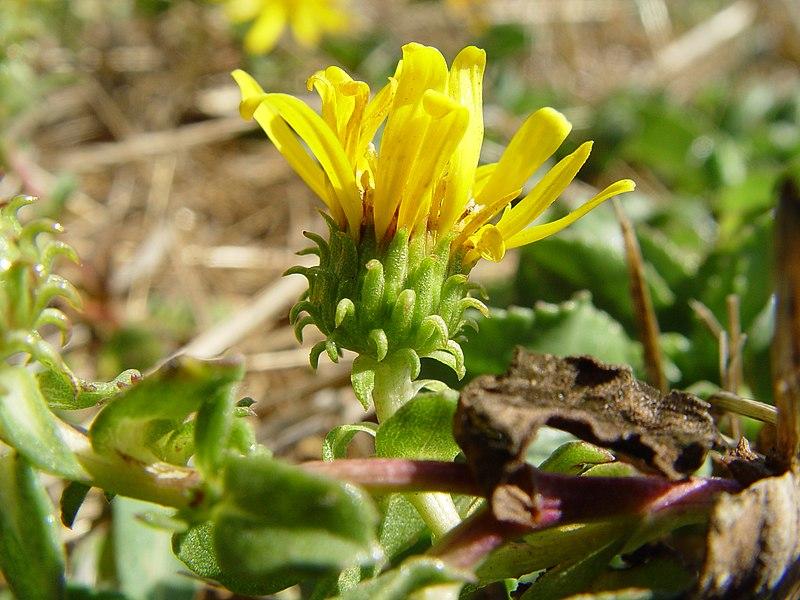
|
Lavandula stoechas ‘Otto Quast’
Pronunciation
lah-VAN-dew-lah STOY-kas
Common Name
Spanish Lavender
Plant Type
Shrub
Mature Size
1 ft. to 2 ft. tall and 2 ft. to 3 ft. wide
Water Requirements
Low: water every three weeks until the root ball is wet
Sun/Shade Requirements
Full sun
Wildlife
Flower Color
Purple
Where to See
Maintenance- Design- Planting Tips
Lavenders are a favorite plant for low-water gardens with their aromatic foliage and showy spikes of scented flowers. Full sun and good drainage are essential for lavenders. Shear the plant after blooming to maintain a neat appearance and discourage the plant from becoming too large and woody. Lavender is a short-lived shrub that may need to be replaced when it becomes leggy or woody after about six years.
Lavandula stoechas is an early bloomer and will repeat bloom if deadheaded and given supplemental water. PADG notes: Several different types of lavenders are planted in the Demonstration Garden, including ‘Otto Quast’, a successful cultivar which is also a UC Davis Arboretum All-Star plant. |
Leonotis leonurus
Pronunciation
lee-oh-NO-tus lee-oh-NURE-us
Common Name
Lion’s Tail
Plant Type
Shrub
Mature Size
4 ft. to 6 ft. wide and tall
Water Requirements
Low: water every three weeks until the root ball is wet
Sun/Shade Requirements
Full sun
Wildlife
Flower Color
Orange-red
Where to See
Maintenance- Design- Planting Tips
This upright shrub from South Africa has bright eye-catching orange flowers. A single lion’s tail works well as a late summer/early fall garden focal point. The flowers can also be stunning in a flower arrangement.
Prune these shrubs in the early spring after the danger of frost is past to control size. Some gardeners prune them down to six inches from the ground; others just cut off half of the total height. How much to prune is a matter of deciding the desirable size of the plants in the garden. With no pruning at all, these plants can get very large, very quickly. Lion’s tail can be frost tender, but they rebound quickly. If this plant does get frost damaged, wait until after the danger of frost is past, then cut off the damaged parts. |
Lessingia filaginifolia
Pronunciation
les-IN-jee-a fi-la-jin-i-FOL-ee-a
Common Name
California Dune Aster
Plant Type
Groundcover
Mature Size
3+ ft. wide and 4 in. tall
Water Requirements
Very Low: water deeply several times a summer
Sun/Shade Requirements
Full to half sun
Wildlife
Flower Color
Pink to lilac
Where to See
Maintenance- Design- Planting Tips
Lessingia felaginifolia is a drought tolerant California native groundcover and a favorite with butterflies. Lessingia ‘Silver Carpet’ is a selection known for its dense, silvery foliage. The short, ground-hugging foliage is only 4 inches high, spreading 3 or more feet. Water deeply a few times over the summer.
|
Linaria purpurea
Pronunciation
lin-AR-ee-uh pur-PUR-ee-uh
Common Name
Purple Toadflax
Plant Type
Perennial
Mature Size
2 - 3 ft. high and 1 ft. wide
Water Requirements
Low: water every three weeks until the root ball is wet
Sun/Shade Requirements
Full to half sun
Wildlife
Flower Color
Where to See
Maintenance- Design- Planting Tips
Linaria is an old friend that asks for little and gives much. This plant makes a great filler, especially in a young garden. The flowers are small, but the plant is large with many blooming branches. Sunset recommends planting these plants in mass for maximum impact.
The big drawback to Linaria is that it reseeds. The seedlings are easy to spot and pull out. If you deadhead the flowers and mulch your soil regularly you will cut down on the amount of reseeding. |
Nepeta x faassenii
Pronunciation
NEP-eh-tah ex. fah-SEEN-ee-eye
Common Name
Catmint
Plant Type
Groundcover
Mature Size
1 ft. tall and 1 1/2 - 2 ft. wide
Water Requirements
Low: water every three weeks until the root ball is wet
Sun/Shade Requirements
Full to half sun
Wildlife
Flower Color
Lavender-blue
Where to See
Maintenance- Design- Planting Tips
Catmint is a reliable and easy edging plant for low water perennial borders. It has lovely soft gray leaves and lavender-blue flowers in the spring.
After the first set of blooms finishes, catmint should be cut back several inches to keep it from getting leggy and encourage another set of blooms. This is a fun job because the leaves have a wonderful smell. Be aware that some cats also love the smell of the plant and will roll their bodies in the plant and flatten it. PADG Notes: Catmint was one of the earliest plants in the Demonstration Garden providing much needed color the first summer. It is used extensively to visually tie the beds together.
|
Origanum
Pronunciation
oh-Rig-an-um
Common Name
Oregano
Plant Type
Perennial
Mature Size
Varies depending on cultivar
Water Requirements
Low: water every three weeks until the root ball is wet
Sun/Shade Requirements
Full sun
Wildlife
Flower Color
No flowers
Where to See
Maintenance- Design- Planting Tips
Herbs like oregano are very attractive, can be mixed with ornamental plantings and thrive under tough conditions. Some oreganos are grown for their aromatic qualities, others for their interesting foliage and others for their attractive flowers. 'Hopley's', a variety with purplish pink flowers that is attractive in pots. 'Aureum', the variety shown in this picture, looks better with morning sun. The hot afternoon sun can bleach its leaves.
Herbs are also great for attracting beneficial insects to gardens. And the less they are watered, the more intense the flavor. Many oreganos benefit from being sheared to the ground in the fall. Harvest oregano any time for cooking, but the most intense flavor is just before the plants bloom. |
Pelargonium ionidiflorum
Pronunciation
pe-lar-GO-nee-um eye-oh-nid-ih-FLOR-um
Common Name
Celery Scented Pelargonium
Plant Type
Groundcover
Mature Size
12 - 18 in. high and 15 -24 in. wide
Water Requirements
Low: water every three weeks until the root ball is wet
Sun/Shade Requirements
Half sun to shade
Wildlife
Flower Color
Magenta pink
Where to See
Maintenance- Design- Planting Tips
Pelargonium ionidiflorum blooms throughout the year with bright pink flowers. Attractive when grown in front of border plants, it stays low and compact and seems to do well in partial shade. Unlike other Pelargoniums, this plant does not get leggy. Maintenance is minimal, and occasional deadheading is all that is needed.
|
Salvia chamaedryoides
Pronunciation
SAL-vee-uh kam-ay-dry-OY-deez
Common Name
Germander Sage
Plant Type
Perennial
Mature Size
2 ft. wide and 3 ft. to 4 ft. tall
Water Requirements
Low: water every three weeks until the root ball is wet
Sun/Shade Requirements
Full sun
Wildlife
Flower Color
Bright blue
Where to See
Maintenance- Design- Planting Tips
|
Salvia Hybrid 'Christine Yeo'
Pronunciation
SAL-vee-uh
Common Name
Sage 'Christine Yeo'
Plant Type
Perennial
Mature Size
12-18 in. high and 24 - 36 in. wide
Water Requirements
Low: water every three weeks until the root ball is wet
Sun/Shade Requirements
Full to half sun, shade
Wildlife
Flower Color
Where to See
Maintenance- Design- Planting Tips
Salvias microphyllas is a shrubby perennial that come in a wide variety of colors and will bloom many months with deadheading. It stays a manageable size in the garden and will not overwhelm neighboring plants.
The flower pictured here is Salvia hybrid 'Cristine Yeo'. It is a cross between Salvia microphylla and Salvia chamaedryoides. PADG Notes: Salvia microphyllas prefer full sun, but this plant is doing well with morning sun and afternoon shade in our garden. It seems a little floppy, which might be a shade issue or just its natural form. With a little work, the Salvia microphyllas can be kept in top form in your garden. At PADG, all flowers are sheared off in early summer and again during fall clean up. This keeps the plant more compact and encourages repeat blooming. In the spring, one third of is oldest stems are pruned out to keep the plant from getting woody. A nice bonus for pruning work -- the leaves of these Salvias smell wonderful. |
Salvia microphylla 'UCB Pink'
Pronunciation
SAL-vee-uh My-kro-FIL-uh
Common Name
Sage 'UCB Pink'
Plant Type
Perennial
Mature Size
3 ft. to 4 ft. wide and tall
Water Requirements
Low: water every three weeks until the root ball is wet
Sun/Shade Requirements
Full sun
Wildlife
Flower Color
Maintenance- Design- Planting Tips
This hot pink Salvia blooms in late fall when few other plants are blooming. In general Saliva microphylla plants do well in summer-dry perennial gardens and don't need a great deal of maintenance.
PADG Notes: 'UCB Pink' seems to bloom more consistently than many of the Salvia microphylla types. In the fall, the skinny branches of this plant are sheared off to form a neat ball. Avoid cutting into the thicker woody stems because it could affect regrowth. Regular pruning keeps this plant fuller and encourages more flowering the next season. If you want to learn more about Salvias, we suggest reading Betsy Clebsch's book called The New Book of Salvias. |
Santolina chamaecyparissus 'Nana'
Pronunciation
san-toh-LEE-nuh kam-ee-ky-par-ISS-us
Common Name
Dwarf Lavender Cotton
Plant Type
Perennial
Mature Size
2 ft. tall and 3 ft. wide
Water Requirements
Very Low: water deeply several times a summer
Sun/Shade Requirements
Full to half sun
Wildlife
Flower Color
Where to See
Maintenance- Design- Planting Tips
Santolina chamaecyparissus 'Nana' is a compact shrub with silver grey foliage and bright yellow flowers. This cultivar is very slow growing and stays a nice size.
PADG Notes: We originally had a full sized Santolina, but the plant fell apart when it bloomed. It was unattractive, so it was removed it from the garden. Santolina chamaecyparissus 'Nana' is a good choice for an edger or in a knot garden because it doesn't require the pruning that the larger species needs. We've used short silver plants as edging throughout the Demonstration Garden to tie the garden together visually. |
Scrophularia californica
Pronunciation
skrof-ew-LAH-ree-uh kal-i-FOR-ni-kuh
Common Name
California Bee Plant
Plant Type
Perennial
Mature Size
6 - 12 in (15 - 30cm) wide x 2 - 4 ft (0.6 - 1.2 m) tall
Water Requirements
Low: water every three weeks until the root ball is wet
Sun/Shade Requirements
Half sun
Wildlife
Flower Color
Red
Where to See
Maintenance- Design- Planting Tips
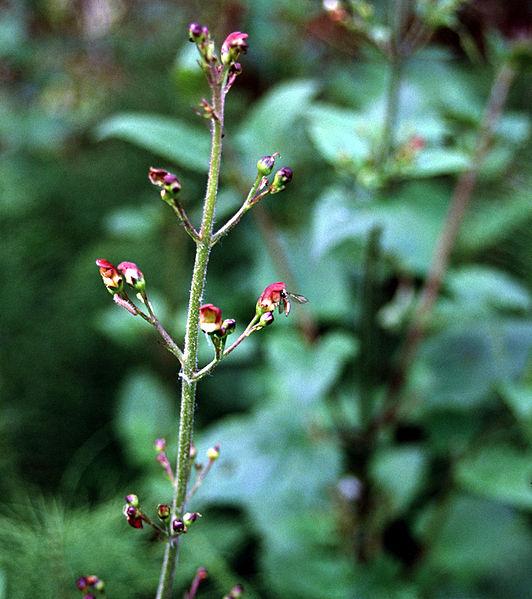
|
Solidago velutina ssp. californica
Pronunciation
so-lid-AH-goh vel-oo-TEE-nuh
Common Name
California Goldenrod
Plant Type
Groundcover
Mature Size
1.5 - 5 ft (0.46 - 1.5 m) tall
Water Requirements
Low: water every three weeks until the root ball is wet
Sun/Shade Requirements
Full to half sun
Wildlife
Flower Color
Yellow
Where to See
Maintenance- Design- Planting Tips
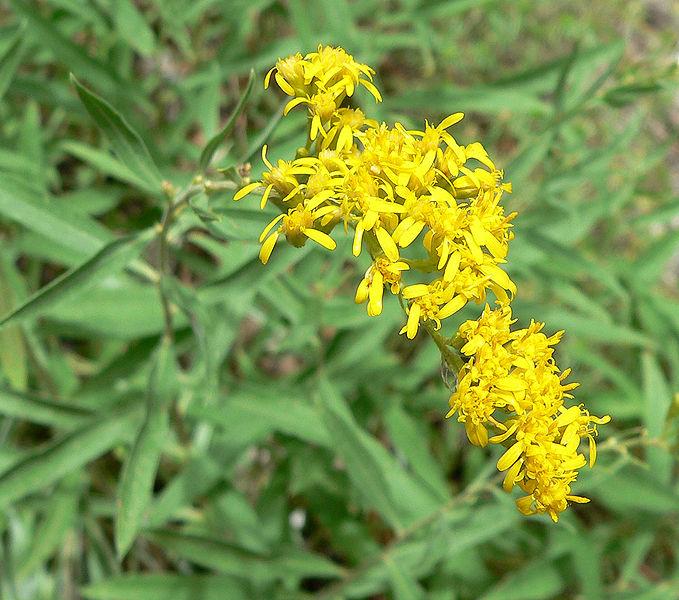
|
Symphoricarpos albus
Pronunciation
sim-for-ih-KAR-pus AL-bus
Common Name
Snowberry
Plant Type
Shrub
Mature Size
3 - 5 ft. tall and wide
Water Requirements
None: avoid summer water
Sun/Shade Requirements
Full to half sun, shade
Wildlife
Flower Color
Where to See
Maintenance- Design- Planting Tips
When fall and winter come, shrubs with berries and fruit add interest to the garden. Snowberry, a California native, has white berries that show up in the fall and last through winter. These berries are attractive to birds too.
One of the best features of snowberry is it does well in dry woodland conditions. It is a rare shrub that will thrive under a thicket of oak trees. Some people find the branching structure of snowberry to be messy. California Native Plants for the Garden recommends occasional coppicing to improve its appearance. Coppicing means to cut back a plant to about one foot from the ground. This usually works best right before a plant puts out new growth in the spring. PADG Notes: Our snowberries grow in a shady area that gets no summer irrigation.
|
Symphyotrichum chilense
Pronunciation
sim-fee-OT-ri-koom chi-LEN-see
Common Name
California Aster (Pacifc Aster)
Plant Type
Perennial
Mature Size
3 ft (0.9 m) wide x 1.3 - 3.3 ft. (0.4 - 1 m) tall
Water Requirements
Low: water every three weeks until the root ball is wet
Sun/Shade Requirements
Full to half sun
Wildlife
Flower Color
Blue, Lavender, Yellow
Where to See
Maintenance- Design- Planting Tips
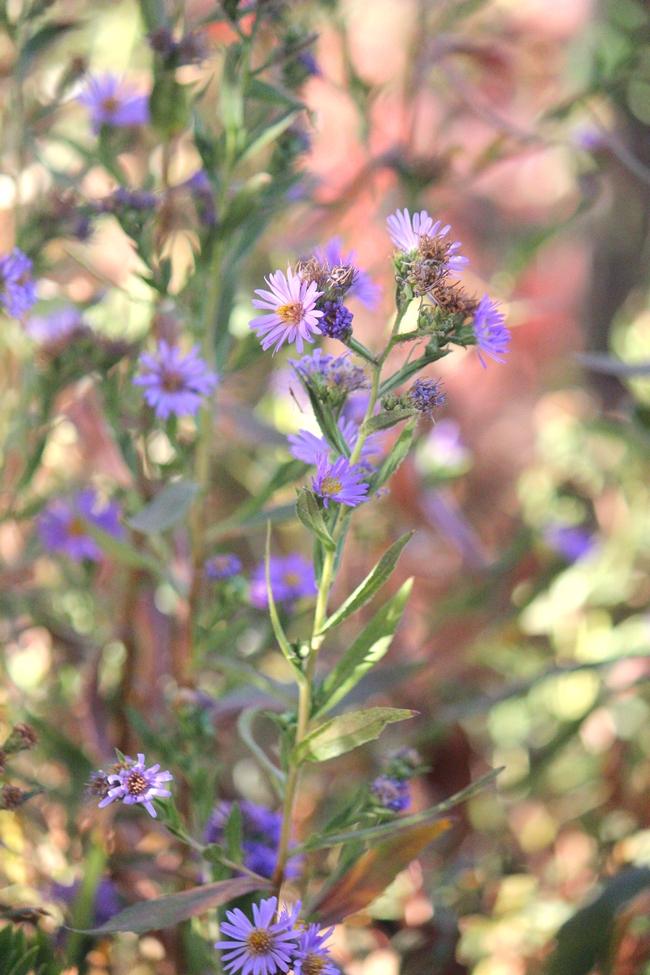
|
Tagetes lemmonii
Pronunciation
tah-JEE-deez lem-mon-ee-eye
Common Name
Mexican Bush Marigold
Plant Type
Perennial
Mature Size
4 ft. to 6 ft. wide and 3 ft. to 6 ft. tall
Water Requirements
Low: water every three weeks until the root ball is wet
Sun/Shade Requirements
Full to half sun
Wildlife
Flower Color
Where to See
Maintenance- Design- Planting Tips
Tagetes lemmonii is a sprawling shrub-like perennial with yellow flowers and aromatic leaves. The plant is originally from Mexico and the southwestern U.S.
PADG Notes: Mexican Bush Marigold can become large and ungainly, so we recommend shearing this plant several inches from the ground in the spring to keep the plant compact and give it a nice shape. Also, prune out any frost damage once the danger of frost is over. Tagetes lemmonii is not long-lived in the garden, but if you like yellow flowers and enjoy the smell of its leaves this plant is worth planting. In the demonstration garden we removed Tagetes lemmonii because it repeatedly suffered frost damage and was not attractive. |
Teucrium fruticans ‘Azureum’
Pronunciation
Tew-kree-um FREW-ti-kanz
Common Name
Bush Germander
Plant Type
Shrub
Mature Size
4 - 6 ft. tall and wide
Water Requirements
Low: water every three weeks until the root ball is wet
Sun/Shade Requirements
Full sun
Wildlife
Flower Color
Violet blue
Where to See
Maintenance- Design- Planting Tips
Teucium fruticans 'Azureum' has attractive blue flowers all winter long. The rest of the year it has a smaller floral display. The deep blue stands out against the grey foliage.
PADG Notes: A drawback to Bush Germander is it can grow to be very large. We pruned ours back to 4 inches to help control its size. The shrub came roaring back with a natural shape and a slightly smaller size. The winter blooms are plentiful. We recently planted a smaller Teucrium cultivar, 'Compactum' that is reputed to stay 3 feet tall and wide and have intense blue flowers. |
Verbena bonariensis
Pronunciation
ver-BEE-na bo-nar-ee-EN-sis
Common Name
Verbena
Plant Type
Perennial
Mature Size
3-6 ft tall x 1-3 ft wide
Water Requirements
Low: water every three weeks until the root ball is wet
Sun/Shade Requirements
Full sun
Wildlife
Flower Color
Purple
Where to See
Maintenance- Design- Planting Tips
Best used as a background plant, Verbena bonariensis does best in hot, dry locations with good air circulation and well-draining soil.
This is a fast-growing plant, which if happy in the garden, will spread by seed. It has a small clump of green leaves that produce tall flowering stems in the hot summer months. The overall look is light and airy. Tall stems should be cut down when flowers have faded. PADG Notes: This plant is no longer in the garden because it needed some supplemental water to keep it thriving. |







